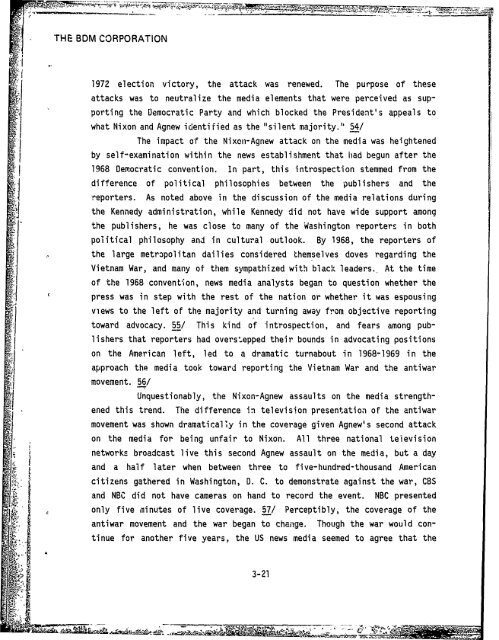policy - The Black Vault
policy - The Black Vault
policy - The Black Vault
Create successful ePaper yourself
Turn your PDF publications into a flip-book with our unique Google optimized e-Paper software.
THE BDM CORPORATION<br />
ki•<br />
J<br />
1972 election victory, the attack was renewed. <strong>The</strong> purpose of these<br />
attacks was to neutralize the media elements that were perceived as supporting<br />
the Democratic Party and which blocked the President's appeals to<br />
what Nixon and Agnew identified as the "silent majority." 54/<br />
<strong>The</strong> impact of the Nixon-Agnew attack on the media was heightened<br />
by self-examination within the news establishment that had begun after the<br />
1968 Democratic convention. In part, this introspection stemmed from the<br />
difference of political philosophies between the publishers and the<br />
reporters. As noted above in the discussion of the media relations during<br />
the Kennedy administration, while Kennedy did not have wide support among<br />
the publishers, he was close to many of the Washington reporters in both<br />
political philosophy and in cultural outlook. By 1968, the reporters of<br />
the large metr3politan dailies considered themselves doves regarding the<br />
Vietnam War, and many of them sympathized with black leaders. At the time<br />
of the 1968 convention, news media analysts began to question whether the<br />
press was in step with the rest of the nation or whether it was espousing<br />
views to the left of the majority and turning away from objective reporting<br />
toward advocacy. 55/ This kind of introspection, and fears among publishers<br />
that reporters had overs'.epped their bounds in advocating positions<br />
on the American left, led to a dramatic turnabout in 1968-1969 in the<br />
approach the media took toward reporting the Vietnam War and the antiwar<br />
movement. 56/<br />
Unquestionably, the Nixon-Agnew assaults on the media strengthened<br />
this trend. <strong>The</strong> difference in television presentation of the antiwar<br />
movement was shown dramatically in the coverage given Agnew's second attack<br />
on the media for being unfair to Nixon. All three national television<br />
networks broadcast live this second Agnew assault on the media, but a day<br />
and a half later when between three to five-hundred-thousand American<br />
citizens gathered in Washington, D. C. to demonstrate against the war, CBS<br />
and NBC did not have cameras on hand to record the event. NBC presented<br />
only five minutes of live coverage. 57/ Perceptibly, the coverage of the<br />
antiwar movement and the war began to change.<br />
Though the war would continue<br />
for another five years, the US<br />
news media seemed to agree that the<br />
"3-21<br />
-- - 177 l><br />
-<br />
$.
















